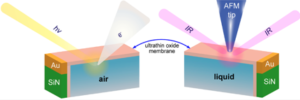APPLICATIONS OF TECHNOLOGY:
- Environmental electron, X-ray, and infrared spectroscopies for molecular-level studies of solid-gas and solid-liquid interfaces
BENEFITS:
- Oxide membranes are amorphous, uniform in thickness, and have compositions similar to those of the corresponding bulk oxides
- Exhibit remarkable mechanical strength and can withstand large pressure differences
BACKGROUND:
- Various surface-sensitive techniques have been developed to characterize the metal-oxide interface with gases and liquids at the atomic/molecular scale. However, the current pressure range where these techniques operate is still lower than that needed in many practical reaction conditions, and their operation in liquid environments remains particularly difficult. To address these issues, thin film membranes acting as windows in environmental cells have been created by Berkeley Lab.
TECHNOLOGY OVERVIEW:
Researchers at Berkeley Lab have developed free-standing ultrathin films of oxide materials that are mechanically robust and transparent to electrons and photons.
They demonstrated that this new generation of metal-oxide membranes can be fabricated via plasma-enhanced atomic layer deposition (PE-ALD) on graphene and on polymer supports. The films act as membranes closing a reaction cell as well as substrates and electrodes for electrochemical reactions. Researchers estimate that this membrane can withstand pressures above 106 Pa, which explains its strong performance as an environmental-cell window to contain high-pressure gas or liquids.
The present invention will pave the way for future studies of catalytic, electrochemical, geochemical, and other reactions at interfaces in practical conditions.
DEVELOPMENT STAGE: Proven principle
PRINCIPAL INVESTIGATORS:
- Yi-Hsien Lu
- Xiao Zhao
- Matthijs van Spronsen
- Adam Schwartzberg
- Miquel Salmeron
- Carlos Morales Sanchez
STATUS: Patent pending.
OPPORTUNITIES: Available for licensing or collaborative research.
